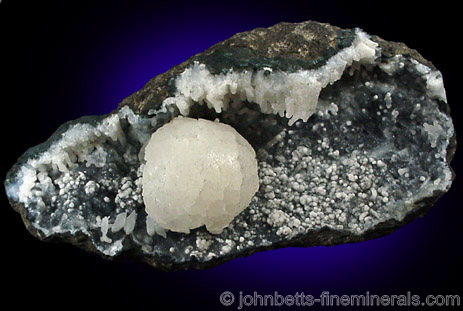The Mineral stellerite

Stellerite is an uncommon member of the zeolite group, and is very similar in structure and formation to Stilbite. Stellerite is named after Georg Wilhelm Steller (1709–1746) a famous German explorer, physician, and zoologist. Steller first discovered this mineral on the Commander Islands (also known as the Komandorski Islands) in far east Russia. Aside from being the first to explore these islands and discover this new mineral, Steller is also credited for identifying several animal species that were named after him, such as the steller's sea lion, and the now-extinct steller's sea cow.
Chemical Formula
CaAl2Si7O18 · 7(H2O)
Color
Colorless, white, yellow, orange, peach, brown
Crystal System
Orthorhombic
Properties
Streak
Colorless |
Hardness
4 - 4.5 |
Transparency
Transparent to translucent |
Specific Gravity
2.1 - 2.2 |
Luster
Pearly |
Cleavage
1,1 |
Fracture
Uneven |
Tenacity
Brittle |
Crystal Habits
Most often as rounded, radial groups. The groups can be clustered together or in separate balls, and may form as perfectly rounded formations. Also in platy aggregates, and in
distinct curved aggregates of fan-shaped, wheat sheaf, or bow-tie bundles. Individual crystals, which are rare, are in flat tabular crystals with pointed tips.
Uses
Stellerite is an uncommon mineral that is highly desired by collectors.
Its only practical use is as specimen for collectors, especially zeolite collectors.
Noteworthy Localities
Although Stellerite is uncommon, it is present in some of the important zeolite deposits and can be mistaken for the much more common Stilbite. Only the significant occurrences will be mentioned here.
Bright orange Stellerite in large crystal groups are well-known from the Sarbaiskoe (Sarbai) and Sokolovskiye Mines, Kostanay Province, Kazakhstan. Large and beautiful crystals occur in several of the famous zeolite localities in Maharashtra, India, including Pune (Poona), Jalgaon, Aurangabad, Nasik. In Australia, large, individual, peach-colored Stellerite crystals come from Garrawilla, Gunnedah, and Tambar Springs, all in Pottinger Co., New South Wales. Yellow Sterllerite comes from Malmberget, Lappland, Sweden; and white microcrystals from Gibelbach, Fiesch, Switzerland.
In the U.S., the most significant locality is the Braen's Quarry, Haledon, Passaic Co., New Jersey, where the Stellerite has been found in lustrous colorless rounded balls. Small yellow Stellerite spheres come from the Kibblehouse Quarry, Perkiomenville, Montgomery Co., Pennsylvania; and white clusters from the Dyer Quarry, Gickerville, Birdsboro, Berks Co., Pennsylvania. Rounded Stellerite plates have come from Ritter Hot Springs, Grant Co., Oregon.
Distingushing Similar Minerals
Stilbite - Often more rounded and glossy; otherwise very difficult to distinguish.